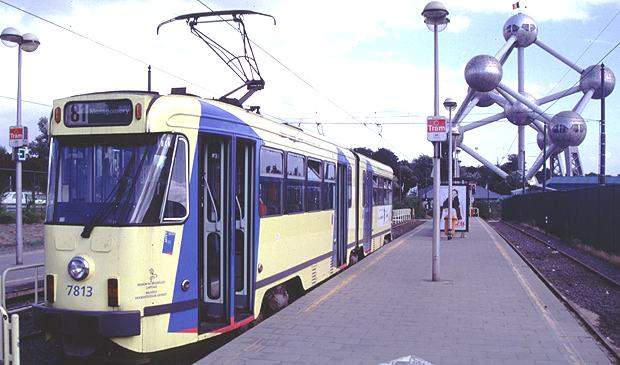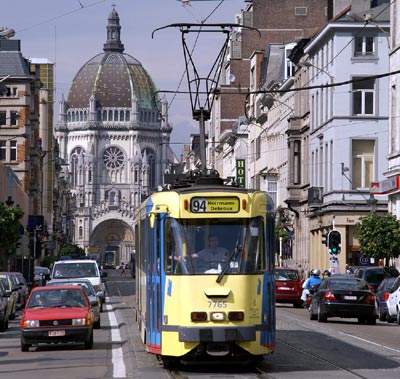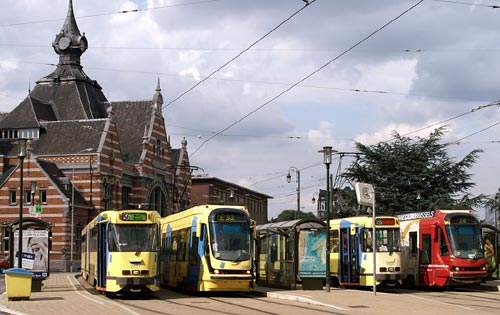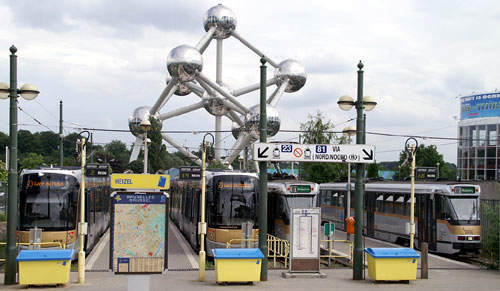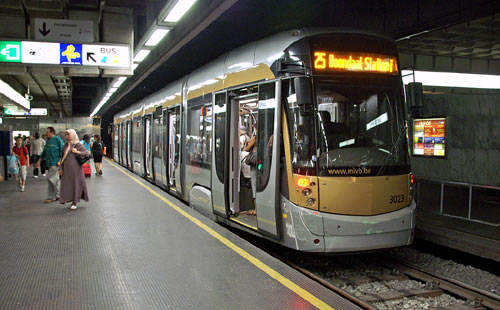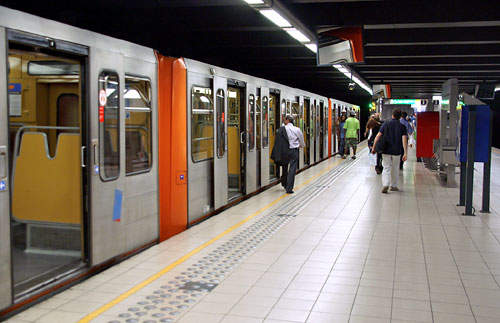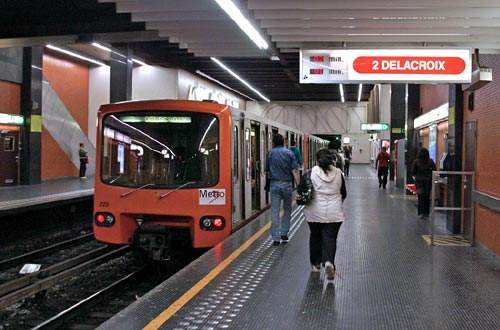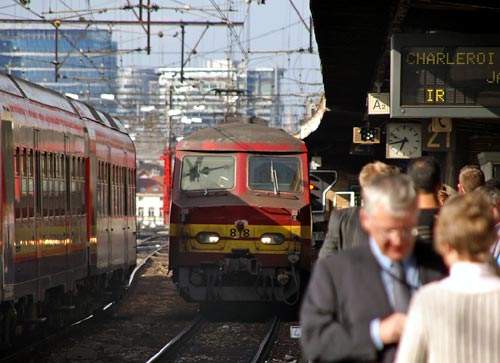Public transport in the 19 communes of the Belgian capital and some adjoining areas is operated by STIB/MIVB (Societé des Transports Intercommunaux de Bruxelles). Set up in 1954, STIB operates three rail modes: tram, pre-metro and full metro, the balance between which has shifted over the years. The Belgian rail network has four metro lines and 18 tram lines.
Although the country experiences domestic regional conflicts, the city has strong multi-national associations that include being the principal location of many European Community institutions and the headquarters of Nato.
Names and signage on the transport network reflect Brussels’ position as an island of official bi-lingualism (although French predominates) just inside the otherwise Flemish-speaking northern part of the country. An autonomous region, including for transport under STIB, Brussels also has coverage by bus services of the two other regions, TEC (Transport En Commun) for Wallonia and De Lijn for Flanders.
As well as its role as a hub for the emerging European high-speed network, Brussels is the main focal point for Belgian national railways, NMBS/SNCB, and the city has heavy rail stopping services at many stations.
The project
Experiencing a 60% increase in ridership between 2000 and 2006, Brussels is in the midst of changes that embrace routes, stock, designations and procedures. Much of this relates to the gradual increase in the metro operation.
Brussels Metro is a three-line operation largely evolved via the practice begun in 1969 of running tram routes with stops underground to initially create ‘pre-metro’, an intermediate mode for eventual transformation to full metro. Services on pre-metro alignments remain designated as tram services.
The first metro opened in 1976 and expansions have followed through many line extensions. The main axis of services is broadly east-west, with north and south branches at either end (lines 1A and 1B). Designated from 1988, Line 2 curves around the north, east and south of the centre and includes Brussels Midi, the main heavy rail station and centre for high-speed TGV, Thalys, Eurostar and ICE services.
Although there is comprehensive coverage of the city, Brussels trams are prone to long end-to-end journey times. Nevertheless, the system has a long-term future and has undergone several rounds of re-equipping, notably with low-floor vehicles with wider doors that improve loading times.
Infrastructure
Both tramway and metro have 1,435mm gauge, although transition from pre-metro to full metro operation requires replacing the overhead supply with third rail, along with substantial station alterations, notably building high platforms. Each of the three metro lines has a history of piece-meal extension since their initial opening, in part contributing to a confusion of routings and identities that is now subject to revision.
Major works at Gare de l’Ouest / Weststation will see it transformed into one of STIB’s main interchanges. The current depot for all Metro lines near the Delta station will be supplemented by a new facility on the west of the city.
Outside of the pre-metro alignments, much of the tramway features traditional street running. The main stimulus to metro development has been the freedom from conflict with crossings and road traffic at ground level, plus obviating the complexity caused by routing different services along the same tracks.
Rolling stock
Metro stock reflects the evolution of the system, spanning over thirty years from the 1976 opening to the latest CAF-sourced vehicles. Ordered in 2004, M6 stock entered passenger service in 2007. Nicknamed ‘Boa’ due to the serpentine effect of the wide through-gangways, these six-car units mark a departure from earlier trains which are formed into two- or three-car units and can run in multiple.
The Boa increases capacity by 50 over previous long-formation trains. All stock can be used across the metro network, and successive generations have been for system expansion rather than replacement of earlier equipment.
Brussels operates a mix of tram types, with a large number of PCC-type high-floor vehicles remaining in service. The first low-floor trams were the 51 purpose-designed T2000 series delivered 1993–1995 by Belgian company BN, later Bombardier.
From 2005 the same company began supply of an order for two variants of the 100% low-floor Flexity Outlook, 49 five-unit T3000 series and 19 seven-unit T4000 series, all including contract maintenance of bogies and traction equipment. Like the M6 Metro stock, these were delivered in STIB’s new ‘art nouveau’-inspired livery that is being applied to older vehicles.
Signalling/communications
Conversion from tramway to metro operation involves a substantial upgrading of signalling and communications systems. This has entailed the provision of in-cab signalling equipment. New rolling stock is fitted with automatic train protection and automatic train control systems, which are used to help maintain the regular interval services which the network advertises.
An additional measure to help maintain schedules is the fitting of ‘greenwave’ radio equipment, which controls and changes traffic lights at road junctions where necessary to give priority to rail-borne vehicles.
Varying levels of passenger information are provided when using the network, although this is supplemented by comprehensive print and web-based services. As well as for regular users, ticketing options account for the needs of visitors and cover all modes within the city zone.
The future
A substantial heavy rail project will help relieve pressure and improve interchanges for passengers on the Brussels metro and tram systems. Belgian rail infrastructure operator Infrabel is involved in the creation of a Brussels Réseau Express Régional (RER) network with four-hourly peak services on radial routes to a radius of 30km from the capital. In part already in hand, this requires quadrupling of two-track routes for the RER trains to avoid conflict with regional, intercity and high-speed trains. Infrabel’s target is for the RER network to be operational by 2015–16.
With the opening of the Metro Line 2 from Delacroix to Gare de l’Ouest in April 2009, there will be a series of re-designations and new routings leading to four designated metro lines and two pre-metro lines.
Deliveries of CAF stock are to continue to 2008, with the intention of concentrating them on the newly designated Line 1, Gare de l’Ouest-Stockel. In January 2008 Bombardier Transportation and STIB signed an agreement for 102 more T3000 Flexity Outlook trams, including a firm order for 87, which was recently increased to 220 trams. With delivery expected between January 2013 and April 2015, the new vehicles will significantly increase the system’s capacity and remove Brussels’ PCC fleet from revenue use.
There are plans to automating lines 1 and 5 by 2016. Construction of new metro line from Brussels North railway station to Schaerbeek through Verbroeckoven is also being planned. The construction of this line is expected to start in 2012 and be completed by 2018. The lines are planned to be further extended to Evere and Uccle.
Ticketing on the STIB network is being transformed by the gradual introduction of new systems including contact-less smartcard readers. The long-established 5.5km north-south pre-metro line linking Gare du Midi and Gare du Nord is subject to a reduction in the number of tram routes using the line. Capacity will however be increased through deployment of the modern low-floor Bombardier stock to replace earlier units.

